The golden lancehead snake is an interesting reptile because it can only be found on Snake Island, a small piece of land 20 miles off the coast of Brazil. The snake has been largely mythologized and made out to be one of the deadliest snakes in the world. However, it’s not even the deadliest pit viper in the world. Today, we will compare a golden lancehead vs a pit viper to show you how the lancehead compares to other pit vipers.
What Makes a Snake a Pit Viper?
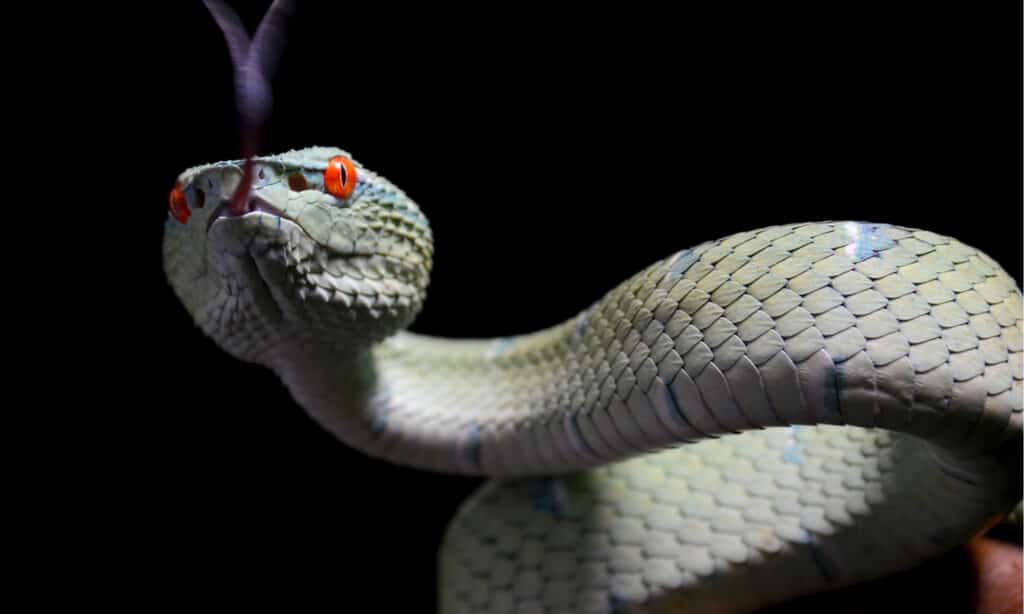
The pit organ is located between the smaller nostril and the eyeball.
©ccarbill/Shutterstock.com
A pit viper is a snake belonging to the subfamily of venomous vipers that have a heat-sensing pit on their face, usually one between each of their eyes and nostrils. These pits allow the snake to pick up on heat signatures, helping them hunt without using their eyes!
Over 20 genera and 150 species of snakes fit under the pit viper designation, and they can be found in many places around the world, including the Americas.
Comparing a Golden Lancehead and a Pit Viper
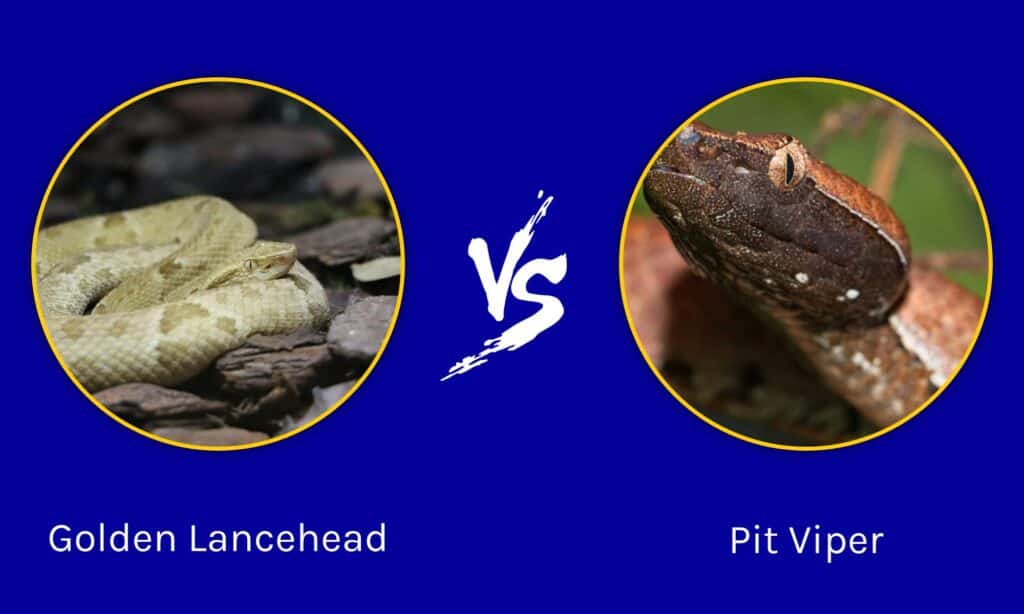
| Golden Lancehead | Pit Viper | |
|---|---|---|
| Size | Weight: 0.5lbs-5lbs Length: 2ft-4ft | Weight: 0.5lb-34lbs Length: 1ft-9.8ft or up to 13ft |
| Venom | – Hemotoxic venom that kills red blood cells and causes tissue damage – Fast absorption rate – Causes severe necrosis of tissue – Has enough venom to kill roughly 10 humans – 5-7% mortality without treatment – 3% mortality rate with treatment | – Venom ranges in potency – Copperheads have a weak venom that may not even be treated with antivenom all the time – Mojave rattlesnakes have deadly hemotoxic venom and neurotoxic venom – 5%-25% mortality rate untreated – 1% mortality rate with treatment but may be disabled |
| Range | – Ilha da Queimada Grande, also known as Snake Island | – Americas, Asia, Eastern Europe |
| Human Interactions | – Few snakebites occur due to the snake living on a quarantined island. | – Are responsible for the most venomous bites in the Americas (copperheads and fer-de-lance) – Responsible for the most deaths in South America (fer-de-lance) |
| Color | – Yellow, tan, cream – Yellow colors can be quite intense and bright | – Brown, tan, black, gray, olive – Rarely integrate bright colors – Usually blends into their environment |
The Key Differences Between a Golden Lancehead vs Pit Viper
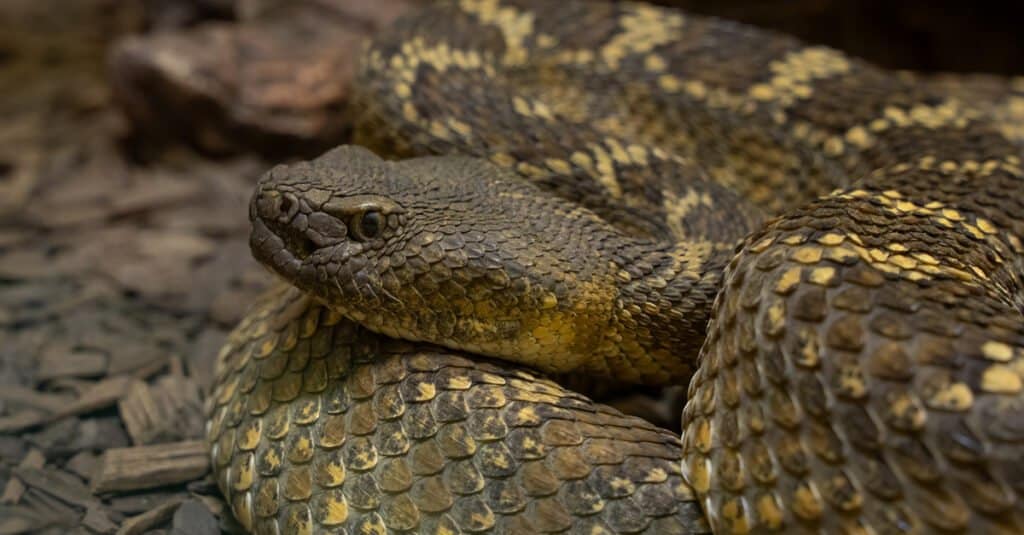
The Mojave rattlesnake shakes its rattler when it is threatened.
©J.A. Dunbar/Shutterstock.com
The greatest differences between a golden lancehead and pit vipers are their size, venom, and colors. Golden lanceheads are small snakes measuring just 4ft long, have a potent venom that can kill many humans, and are known for their yellow skin. Other pit vipers can grow over 10ft long, possess earthy colors, and have deadlier venom with several times the mortality rate.
As we’ve said, the golden lancehead has been mythologized, but it’s not the largest or most dangerous member of the pit viper family.
Golden Lancehead vs Pit Viper: Size
For the most part, golden lanceheads are smaller than pit vipers. Golden lanceheads are rather small snakes, measuring up to 4ft and weighing perhaps 5lbs when fully grown.
However, other pit vipers can get much longer. The Lachesis pit vipers also called bushmasters, are the largest pit vipers in the world. They can apparently grow up to 13ft long. Yet, some of the smallest pit vipers only grow about a foot long, like the pygmy rattlesnake.
Also, small pit vipers can weigh as little as 0.5lbs, or they can weigh as much as 34lbs like the largest rattlesnake ever found! Either way, many pit vipers are larger than the golden lancehead.
Golden Lancehead vs Pit Viper: Venom
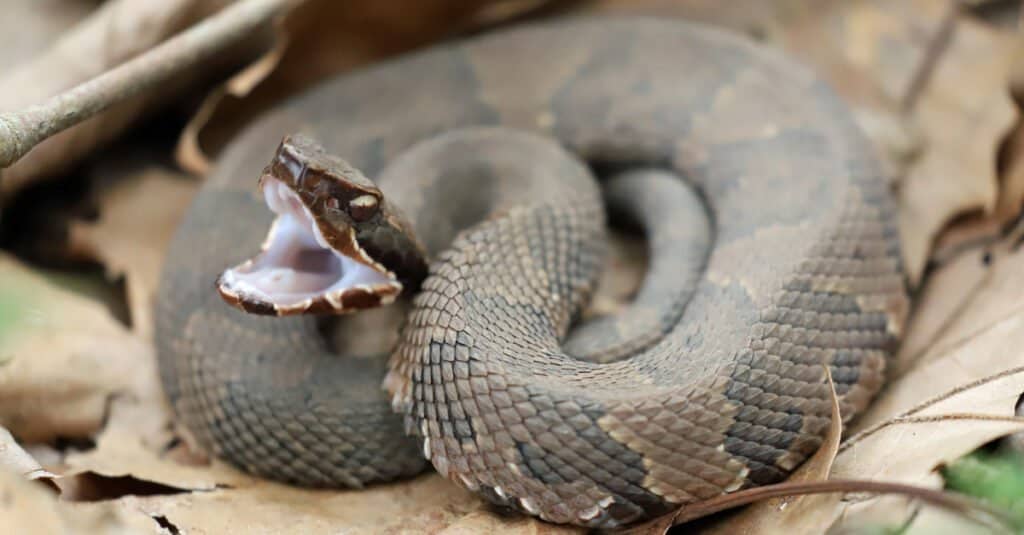
Although cottonmouths are venomous, their venom is not as powerful as a golden lancehead’s.
©KF2017/Shutterstock.com
Golden lanceheads have weaker venom than many pit vipers. The venom of the golden lancehead is dangerous because it is a hemotoxin that contains a strong cytotoxin. The chemical cocktail they possess is powerful, killing 7% of all people who do not have the treatment and 3% of those who do.
However, research into this snake’s venom is difficult because their island is closed to the public. Thus, researchers rely on modern-day piracy to retrieve and test snakes.
Nevertheless, many other pit vipers have deadlier venom than the golden lancehead. For example, the Mojave rattlesnake bites with a combined hemotoxic and neurotoxic venom that can kill upwards of 25% of all people that do not get treated with antivenom. Other pit vipers, like copperheads, have a very mild bite that needs treatment but may not require antivenom to save the victim’s life.
Golden Lancehead vs Pit Viper: Range
The golden lancehead is only found on Snake Island, a small island located 20 miles off the coast of Brazil. These snakes became trapped on the island due to terrain shifts that left a large swath of ocean between them and the mainland.
Pit vipers are found in Europe, Asia, and the Americas. Some vipers live in Africa, but they’re not pit vipers. Remember, all pit vipers are vipers, but not all vipers are pit vipers. The presence of the specialty organs is what makes them unique.
Golden Lancehead vs Pit Viper: Human Interactions
The golden lancehead does not have the opportunity to bite or interact with human beings very often. The island they live on is quarantined by the Brazilian government and controlled by the Navy.
However, thousands of people are bitten by pit vipers around the world each year. In South America, the fer-de-lance is responsible for thousands of bites. In the United States, copperheads inflict over 1,000 bites each year.
Pit vipers also bite a lot of people in Eurasia, but not so many as members of the “Big 4”, so their bites tend to get overshadowed.
Golden Lancehead vs Pit Viper: Color
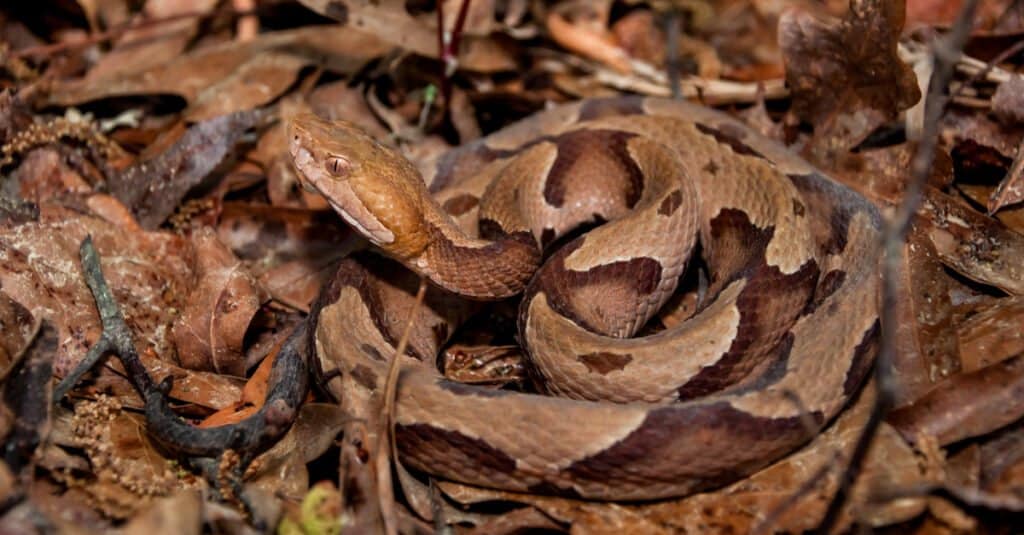
Copperheads can easily blend in with detritus.
©Jay Ondreicka/Shutterstock.com
As their name suggests, the golden lancehead usually appears in yellow, tan, or cream colors. The yellows on their skin can be vivid, too. However, most pit vipers blend in with their surroundings, contributing to the number of people they bite each year.
For example, the copperhead can sit on a pile of fallen leaves and look nearly indistinguishable. Sometimes, rattlesnakes can be hard to spot while sunning on some rocks. The color differences between pit vipers and golden lanceheads are profound.
All in all, even though the golden lancehead is a pit viper, it’s quite unusual. Its size, venom potency, location, and more make the snake very distinct. Fortunately, the chances of encountering that snake are incredibly low.
The photo featured at the top of this post is © Nayeryouakim / Creative Commons – License / Original
Discover the "Monster" Snake 5X Bigger than an Anaconda
Every day A-Z Animals sends out some of the most incredible facts in the world from our free newsletter. Want to discover the 10 most beautiful snakes in the world, a "snake island" where you're never more than 3 feet from danger, or a "monster" snake 5X larger than an anaconda? Then sign up right now and you'll start receiving our daily newsletter absolutely free.
Thank you for reading! Have some feedback for us? Contact the AZ Animals editorial team.






